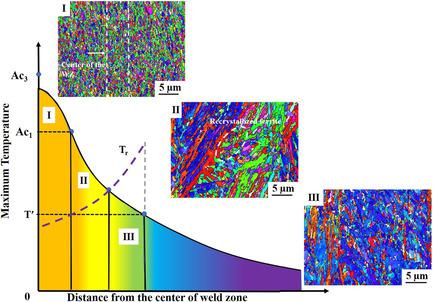当前位置:
X-MOL 学术
›
Steel Res. Int.
›
论文详情
Our official English website, www.x-mol.net, welcomes your feedback! (Note: you will need to create a separate account there.)
Microstructure and Mechanical Properties of Inertia‐Friction‐Welded Fe–Cr–Ni–Mo High‐Strength Steel
Steel Research International ( IF 2.2 ) Pub Date : 2020-06-02 , DOI: 10.1002/srin.202000145 Le Zai 1 , Guoqiang You 1, 2 , Xin Tong 1 , Yuhan Ding 1 , Xuanxi Xu 1 , Qing Liu 1, 3
Steel Research International ( IF 2.2 ) Pub Date : 2020-06-02 , DOI: 10.1002/srin.202000145 Le Zai 1 , Guoqiang You 1, 2 , Xin Tong 1 , Yuhan Ding 1 , Xuanxi Xu 1 , Qing Liu 1, 3
Affiliation

|
Inertia friction welding (IFW) is a solid‐state welding technology that avoids defects associated with molten weld processes; however, this process has rarely been used to weld ultrahigh‐strength steel (UHSS). Herein, 32CrMnSi2Ni6MoV UHSS is joined successfully via IFW. The mechanical properties after welding at different rotational speeds and the microstructure at 2800 rpm are studied in detail. The temperature distributions in the peripheral and central areas are modeled according to the temperature at the weld zone. The microstructural transformation is analyzed for different temperature intervals, and the microstructural characteristics of each interval correspond to the actual microstructure of the welded joint according to the temperature distribution model. High‐strength martensite forms at the weld zone, and the thermomechanical‐affected zone (TMAZ) in the peripheral region is divided into phase transformation zone, partial recrystallization zone, and plastic deformation zone, whereas the TMAZ in the central region includes only the partial recrystallization and pure plastic deformation zones. This difference is due to the higher frictional heat caused by the higher peripheral linear velocity during rotation. A tensile test shows that fracture occurs in the base metal (BM) region, and the yield strength, tensile strength, and elongation are 805 MPa, 1064 MPa, and 13.88%, respectively.
中文翻译:

惯性摩擦焊接Fe–Cr–Ni–Mo高强度钢的组织和力学性能
惯性摩擦焊接(IFW)是一种固态焊接技术,可避免与熔融焊接工艺相关的缺陷。但是,该工艺很少用于焊接超高强度钢(UHSS)。此处,通过IFW成功地加入了32CrMnSi2Ni6MoV UHSS。详细研究了不同转速下焊接后的机械性能和2800 rpm下的显微组织。根据焊接区域的温度对外围和中心区域的温度分布进行建模。分析了不同温度区间的微观组织转变,根据温度分布模型,每个区间的微观组织特征与焊接接头的实际微观组织相对应。在焊接区形成高强度马氏体,外围区域的热机械影响区(TMAZ)分为相变区,部分再结晶区和塑性变形区,而中心区域的TMAZ仅包括部分再结晶区和纯塑性变形区。这种差异是由于旋转过程中较高的圆周线速度导致较高的摩擦热。拉伸试验表明,在母材(BM)区域中发生断裂,屈服强度,拉伸强度和伸长率分别为805MPa,1064MPa和13.88%。这种差异是由于旋转过程中较高的圆周线速度导致较高的摩擦热。拉伸试验表明,在母材(BM)区域中发生断裂,屈服强度,拉伸强度和伸长率分别为805MPa,1064MPa和13.88%。这种差异是由于旋转过程中较高的圆周线速度导致较高的摩擦热。拉伸试验表明,在母材(BM)区域中发生断裂,屈服强度,拉伸强度和伸长率分别为805MPa,1064MPa和13.88%。
更新日期:2020-06-02
中文翻译:

惯性摩擦焊接Fe–Cr–Ni–Mo高强度钢的组织和力学性能
惯性摩擦焊接(IFW)是一种固态焊接技术,可避免与熔融焊接工艺相关的缺陷。但是,该工艺很少用于焊接超高强度钢(UHSS)。此处,通过IFW成功地加入了32CrMnSi2Ni6MoV UHSS。详细研究了不同转速下焊接后的机械性能和2800 rpm下的显微组织。根据焊接区域的温度对外围和中心区域的温度分布进行建模。分析了不同温度区间的微观组织转变,根据温度分布模型,每个区间的微观组织特征与焊接接头的实际微观组织相对应。在焊接区形成高强度马氏体,外围区域的热机械影响区(TMAZ)分为相变区,部分再结晶区和塑性变形区,而中心区域的TMAZ仅包括部分再结晶区和纯塑性变形区。这种差异是由于旋转过程中较高的圆周线速度导致较高的摩擦热。拉伸试验表明,在母材(BM)区域中发生断裂,屈服强度,拉伸强度和伸长率分别为805MPa,1064MPa和13.88%。这种差异是由于旋转过程中较高的圆周线速度导致较高的摩擦热。拉伸试验表明,在母材(BM)区域中发生断裂,屈服强度,拉伸强度和伸长率分别为805MPa,1064MPa和13.88%。这种差异是由于旋转过程中较高的圆周线速度导致较高的摩擦热。拉伸试验表明,在母材(BM)区域中发生断裂,屈服强度,拉伸强度和伸长率分别为805MPa,1064MPa和13.88%。



























 京公网安备 11010802027423号
京公网安备 11010802027423号